Requirements for grape varieties for Siberia and a review of the best of them
Garden grapes prefer sunlight and warmth, so most varieties show high yields in warm regions. However, a number of varieties bear fruit well in harsh climatic conditions - in Altai and Siberia. According to the ripening period, grapes are divided into early, middle and late; by color - dark and white; by purpose - technical and canteen. When choosing grapes, pay attention to early ripening, self-fertility, frost resistance, and immunity. We will tell you in the article what grape varieties summer residents choose for Siberia and Altai.
Requirements for grape varieties for Siberia and Altai
For Siberia and the Altai Territory they choose unpretentious and frost-resistant varieties grapes, which quickly adapt to the climatic conditions of the regions. Recommended frost resistance — before -30°C. Also pay attention to the plant’s immunity — To get a rich harvest, grapes must be resistant to powdery mildew, oidium, anthracnose, and mildew. Varieties with weak immunity and low frost resistance will not take root in Altai or Siberia.
Top best
Which varieties to choose for planting in Altai and Siberia? Let's talk about the most suitable ones.
Rusven
Table grape variety Rusven is universal — it is suitable for fresh consumption and processing, transportation and long-term storage. The bush is medium-sized, moderately spreading. The shape of the bunch is cone-shaped, weight - from 350 to 1000 g.The berries are oval, the weight of one is about 50 g, the color is pinkish-green.
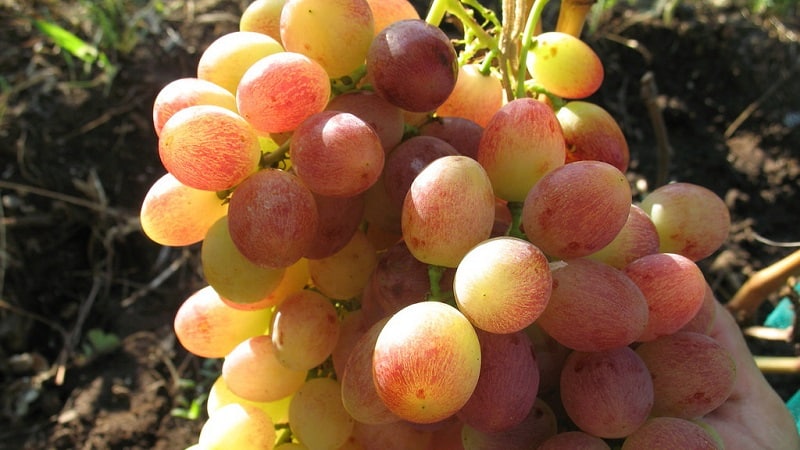
The ripening period of grapes is 110 days, frost resistance is down to -30°C. The taste is harmonious, sweet and sour, with a pronounced nutmeg aroma. The skin is thin but durable. Rusven is early-bearing, produces the first harvest in the second year after planting.
Codrianca
Table variety super early ripening - harvested in 117 days. The bushes are vigorous, the leaves are dark green, medium in size. The weight of the bunch is about 600 g, the shape is conical. The berries are long, black, the flesh is sweet and crisp. Kodryanka’s tasting score is 8.2 points. For the winter, the bushes are covered with agrofibre or slate; in the spring, the shoots are pruned and the crown is formed - the yield of the variety depends on these procedures. Ripe fruits are transportable and universal in use.
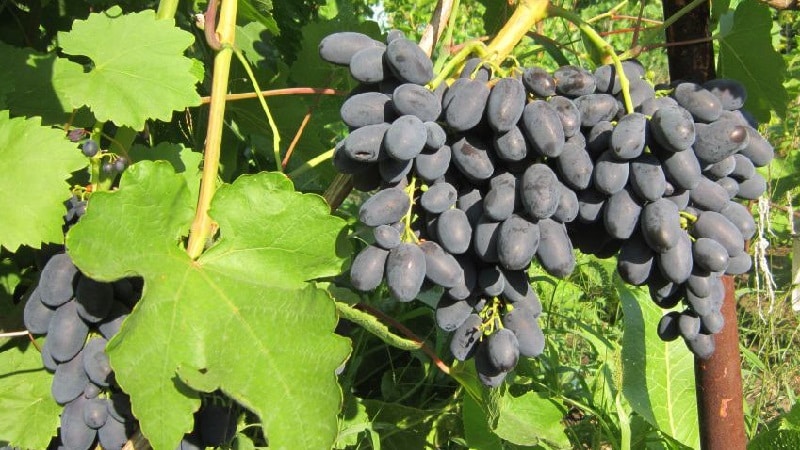
Amursky
The original bushes have a vine-like shape - plants are used not only for harvesting grapes, but also for decorating the garden plot. Young shoots are light green, while mature bushes are brown. The leaves are large and of different shapes. Amur blooms in the first half of May. The clusters are cone-shaped, one weighs on average 500 g. The weight of the berry is 10 g, the shape is oval-round, the color is blue with a waxy coating. The pulp is dense and juicy, greenish in color. The taste is sweet and sour, pleasant. Amur is used fresh and for making jam, preserves, and juice.
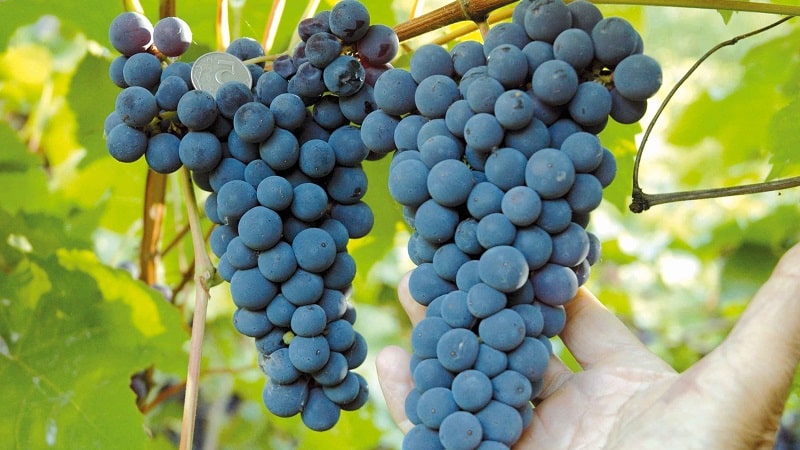
Interesting! In the coldest regions, grapes are grown in greenhouses. The height of the structure must be at least 3 m. It is recommended to choose greenhouses with built-in heating and humidification systems. In the process of growing It is important to regularly ventilate the room and take preventive measures to protect against diseases and insects.
Extra early red nutmeg
Table frost-resistant Red Muscat ripens in 90-100 days from the moment the buds open. The bushes are medium-sized, the shoots ripen quickly. The leaves are rounded and dissected. The clusters are cone-shaped, winged, the weight of one varies from 300 to 600 g. The shape of the berries is oval, one weighs about 5 g, the color is purple-red, attractive. Frost resistance of Extra Early Red Muscat is down to -27°C. The flesh is crispy and fleshy, with small seeds, the peel is dense. The taste is sweet and nutmeg, rated at 7.7 points. Suitable for sale, transportable. Resistant to gray rot, oidium, mildew.
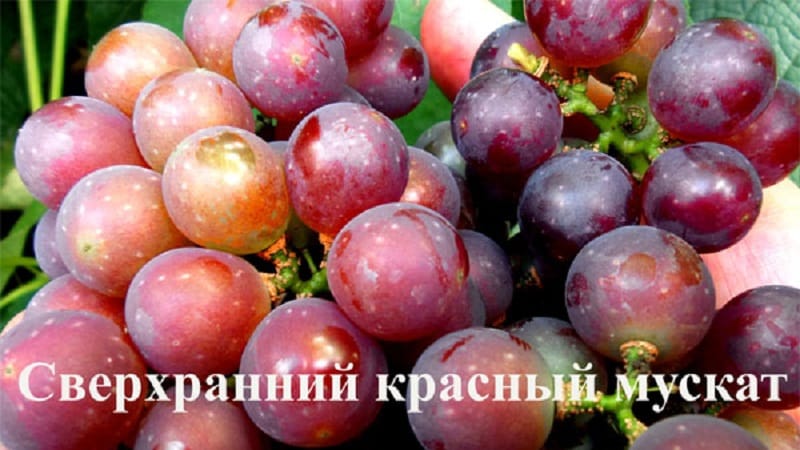
Tukay
The ripening period of Tukay grapes is 90-95 days, the harvest is harvested in mid or late July. The bushes are tall, 1.5-3 m high, the foliage is dense. The clusters are large, weight - from 800 to 1000 g, cylindrical-conical shape. The berries are white or yellow-green, oval, weight - 5 g. The pulp is tender and juicy, the peel is thick with a waxy coating. The grapes sit tightly on the bunch and do not fall off; they are rarely damaged by wasps. Tukai's flowers are bisexual, so the plant does not need pollinating insects or other grape varieties in the neighborhood. The berries have a universal purpose - they are suitable for fresh consumption, transportation, and storage.
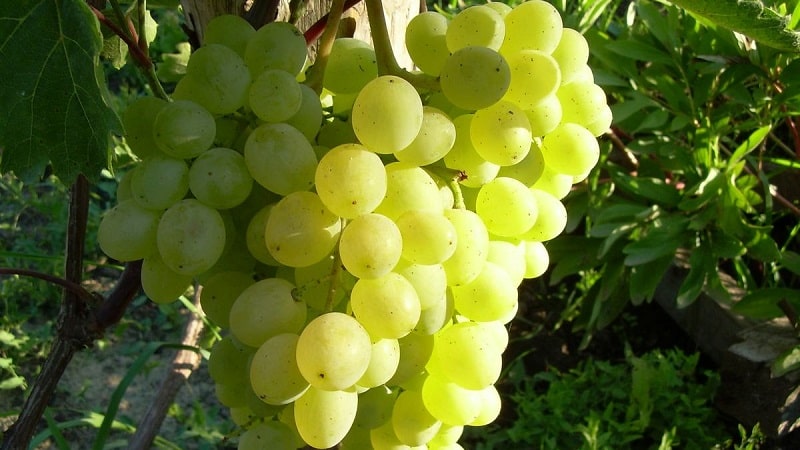
Interesting! Tukai grapes do not spoil for 4-5 months. After harvesting, the bunches are stored in a dry, well-ventilated area at a temperature of +7°C. Wooden boxes, racks, or wall-hung mounts are ideal for storage. The bunches should not touch each other.
Muromets
Ultra-early Muromets tolerates temperatures down to -25°C and does not require shelter for the winter, which makes caring for the plant easier. Table plant, medium-sized bushes, small pubescent leaves. The bunch is conical, medium density, weight - about 400 g. The berries are purple, oblong-oval, weighing about 5 g. The skin is thin with a waxy coating, the fruits are stored for a long time, do not crack or fall off after ripening. The pulp is medium dense, tender and crispy, each berry contains 1-2 small seeds. The taste of Muromets grapes is simple and harmonious. Plantings are rarely damaged by insect pests and diseases.
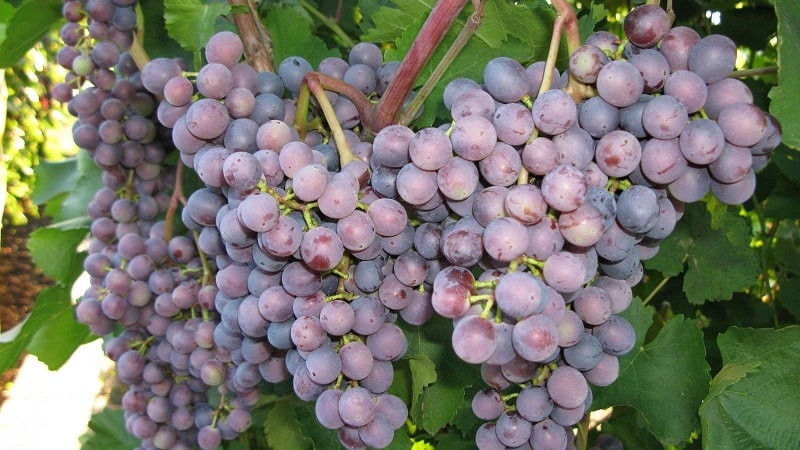
Amethyst
Superranium is a universal variety. Frost resistance - down to -35°C. Ripening time is 90-105 days. The bushes are tall, spreading is average. The weight of the bunch is from 200 to 700 g, the shape is elongated, cone-shaped, the color is dark pink with a purple tint. The berries are conical in shape, weighing 6-8 g per one. The taste is sweet and sour, balanced, with a pronounced aroma. Tasting score: 8.1 points. Amethyst self-fertile, which ensures stable yield. The shoots ripen quickly and the grapes are harvested in early August. Fruiting begins in the third year after planting.
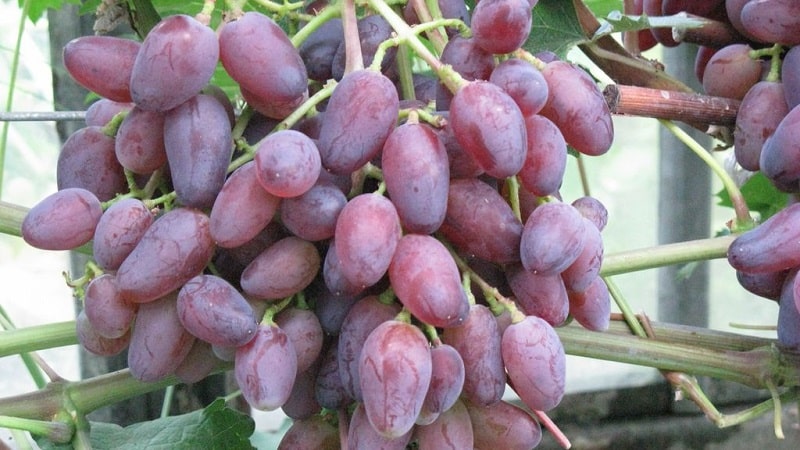
Anthracite
An early ripening table variety. The bushes are medium-sized, the shoots are light brown, the leaves are wrinkled and dissected. The flowers are bisexual, the clusters are conical, the average weight is 750 g. The berries are ovoid, blue-black, the weight of one is about 5 g. The pulp is fleshy, the taste is simple, the aroma is not pronounced. Tasting score: 8.4 points. Anthracite is transportable and rarely damaged by fungal and viral diseases. For the winter requires shelter. The frost resistance of the variety is down to -26°C; Anthracite is grown in the Urals and Siberia.
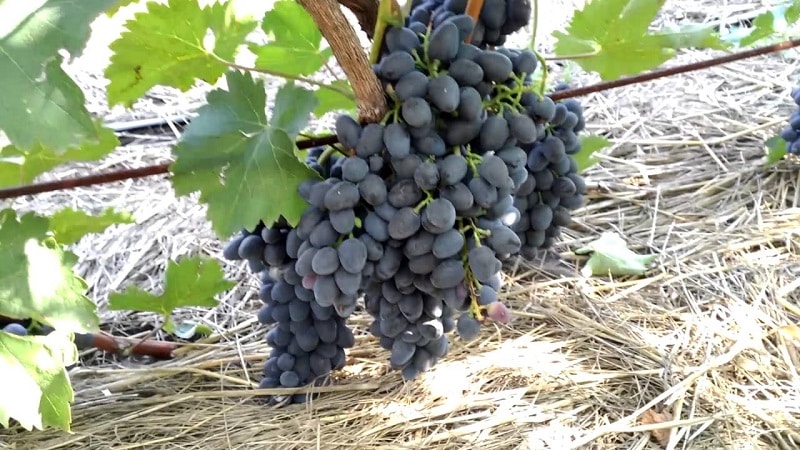
The best early-ripening, mid-ripening and late-ripening grape varieties
From early varieties summer residents highlight Augustine grapes. Table variety, ripening period - 100-110 days. The weight of the conical bunch is about 500 g, the berries are dense, with a pleasant sweet taste. The variety is self-fertile and transportable, universal in use. Frost resistance - down to -25°C.
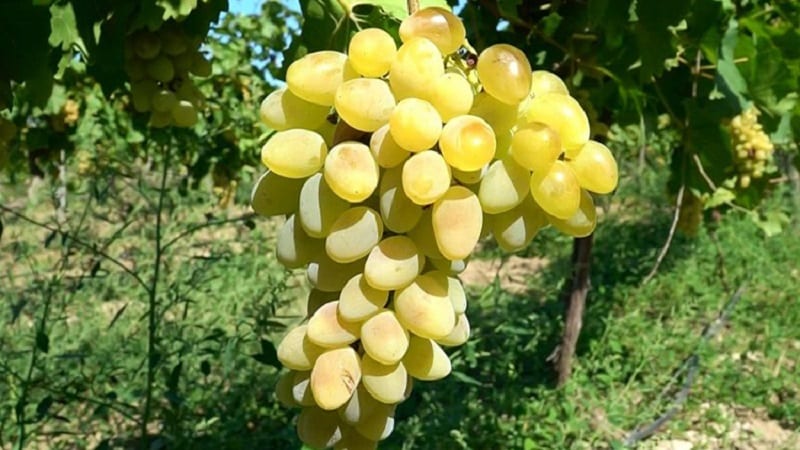
White Muscat grapes are also in demand among early-ripening varieties.. In terms of ripening period, it is medium early. The berries are round, the weight of the bunch is 100-180 g. The color is sweet, the aroma is nutmeg. Early grapes are used for fresh consumption and processing. To obtain a rich harvest, it is recommended to cover early ripening varieties for the winter.
Of the mid-season varieties, it is recommended to pay attention to the Beauty of the North. The ripening period is 115-120 days, the harvest is harvested in late August or early September. The clusters are loose, weight - about 250 g. The berries are large, white-pink in color. The pulp is juicy with small seeds, the taste is sweet, the aroma is pleasant grape. A table variety, the harvest is suitable for processing and fresh consumption.
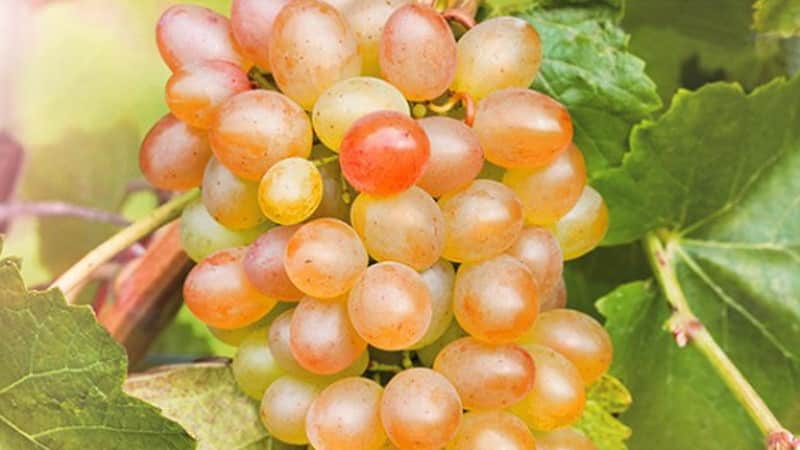
The late-ripening variety Pamyati Verderevsky is also popular among summer residents.. The plant produces large ovoid berries, the weight of one is 6-7 g. The clusters are of medium density, conical, weighing 300-400 g. The harvest is stored for 4-5 months without loss of taste and marketability, frost resistance - down to -24°C. The shoots ripen quickly and the yield is stable. Resistance to mildew and spider mites is high.
Interesting! Of the late varieties, gardeners distinguish Dekabrsky, Red Globe, Original, and Dachny.In Altai and Siberia they are planted in spacious and well-lit areas next to low-growing plants. If plant grapes in shade or partial shade or next to tall bushes, this will negatively affect the yield.
Technical and canteens
Technical varieties are grown for processing — wines, juices, champagne, cognac are made from grapes. Yield technical variety - Ruby Azos. Medium late, fruits are harvested in September. The clusters are branched and loose, weight is about 300 g. The berries are round, the weight of one is 2 g. The skin is dark blue, the rind is dense, the flesh is sweet and juicy. Tasting score: 7.9 points. Among the advantages of the variety are increased resistance to diseases and pests.
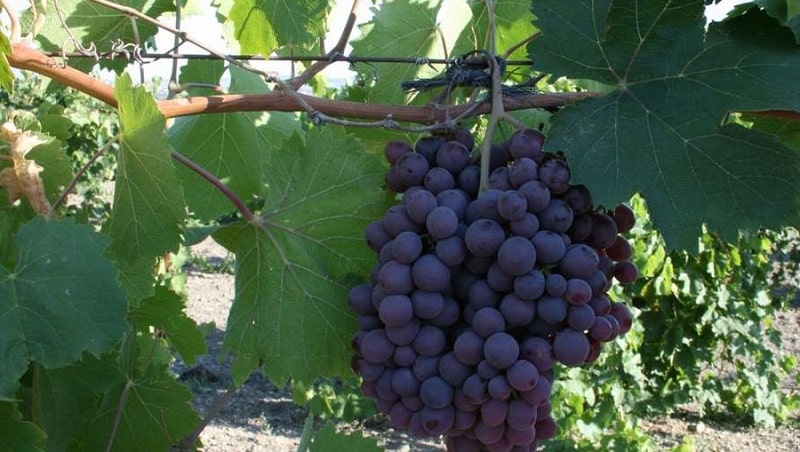
Another technical frost-resistant variety Ryabinsky. Early ripening, self-fertile. The plant is medium-sized and does not require special skills to grow. The weight of the bunch is 180 g, the berries are dense, oval, white in color. The pulp is juicy, the taste is simple, the juice is colorless. Ryabinsky grapes are used to make dry wine - the tasting score is 7.8 points. Grapes are rarely affected by diseases and require shelter for the winter.
Dining rooms
Table varieties have sweeter and more pleasant pulp, thin skin, delicate taste. Variety Skungub 2 is universal to use and unpretentious to grow, with frost resistance down to -25°C. The bushes are medium-sized, the leaves are slightly pubescent. The clusters are medium dense, weigh about 230 g, the berries are black and oval. The taste is pleasant, the tasting rating of fresh grapes is 8.4 points.
For fresh consumption, gardeners grow table grape variety Yubileiny Skuinya. The bushes are medium-sized, the weight of the bunch is 200 g, the shape is conical-cylindrical.The berries are oval, light green in color, the pulp has a harmonious taste, sweet with a pleasant sourness. To obtain a rich harvest, it is recommended annually fan pruning and remove old dry shoots.
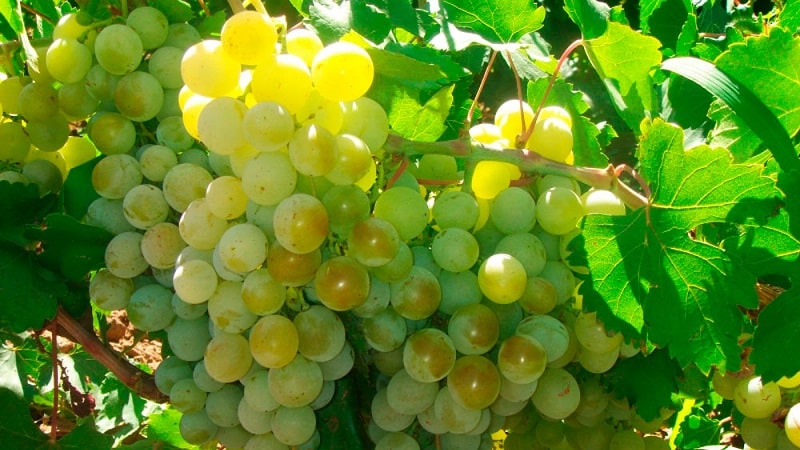
White, dark and pink varieties
White grapes distinguished by sweet and sour pulp. It is eaten fresh or used for preparations. The universal variety of white grapes Rusbol is frost-resistant, can withstand temperatures as low as -25°C, and is resistant to mildew. The berries are oval, the taste is sugary and pleasant. Productivity is about 10 kg per plant.
Bazhen grapes also perform well in harsh climatic conditions.. The flowers are bisexual, the berries are long, the weight of one is about 13 g. The color is yellow-green, the fruits shimmer in the sun. The taste is sweet and harmonious. The shoots ripen quickly and uniformly, and the bisexual flowers provide stable yields.
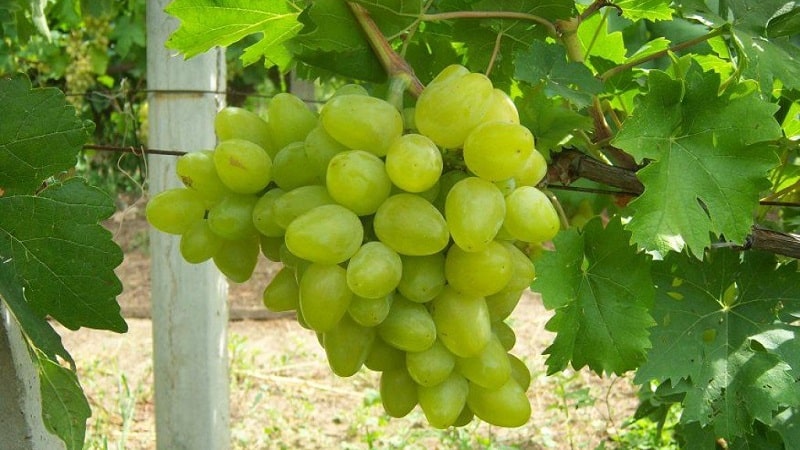
Among the pink varieties, the following varieties are distinguished: Preobrazhenie and Muscat Rozoviy.. They are early ripening and require shelters for the winter, sensitive to mineral and organic fertilizers. The fruits are red-pink, dense and elastic, oval-ovoid in shape. The varieties are frost-resistant, rarely suffer from oidium, powdery mildew, mildew and fruit rot. The harvest is used in fresh and processed form; the berries are distinguished by their transportability and shelf life.
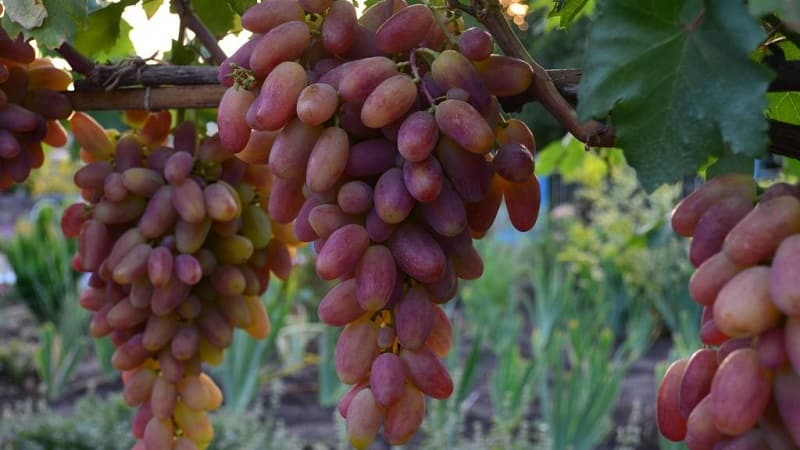
Dark varieties They are mainly used for processing, from which dry and semi-dry wines and wine-containing drinks are prepared. In addition to the Kodryanka variety, the dark Black Cherry grape is popular. The clusters are loose, the weight of one reaches 1000 g. The color is dark purple, the peel is dense, the flesh is light pink. The variety is early-bearing and begins to bear fruit in the second year after planting.The berries are crunchy and tasty, with a pleasant sweet aroma.
How to choose a grape variety for Siberia
When choosing a variety, pay attention to the immunity and frost resistance of grapes, as well as taste and commercial qualities. For processing, fruits with sweet pulp and thin skin are grown - they are used to make jams and preserves. For transportation and storage, grapes with thick skins and a waxy coating are grown - the grapes are stored in dry cellars or basements at a temperature of about +7°C.
It is recommended to plant uncovered and unpretentious varieties - they do not require much attention; during the growing process they are watered and fertilized once a year carry out pruning and bush shaping. In the northern regions, heat-loving grapes especially need mineral supplements - double superphosphate, nitrogen, ammonium nitrate, potassium salt.
Conclusion
Siberian and Altai varieties Kodryanka, Tukay and Rusven are distinguished by their frost resistance and immunity - the grapes are rarely affected by diseases and are resistant to insect pests. The table variety Yubileiny Skuinya is ideal for consumption “from the bush”, the technical variety Ryabinsky is ideal for processing and making wine and champagne.
The yield of grapes depends on the preparation of the soil, the choice of planting site, and compliance with agrotechnical rules. Despite their winter-hardy qualities, most varieties require shelter for the winter. Before purchasing a seedling, it is recommended to study photos of grapes and reviews from experienced gardeners.